I have been working for a long time now on modelling an open quantum system using the Lindblad Equation. The Hamiltonian is the following:
However, two other matrices are added to the Hamiltonian. One of them has all the diagonal terms equal to -33.3333i and everything else zero. Another is a matrix with the third diagonal term equaling -0.033333i.
The Lindblad Equation is this:
where L_i are matrices (in the list: [L1,L2,L3,L4,L5,L6,L7]). The matrix for L_i is simply a 7x7 matrix with all zeros except L_(ii)=1. H is the total Hamiltonian,  is the density matrix, and
is the density matrix, and  is a constant equal to
is a constant equal to  where T is the temperature, k is the Boltzmann constant, and
where T is the temperature, k is the Boltzmann constant, and  , where h is Planck's constant. (Note that gamma is in natural units)
, where h is Planck's constant. (Note that gamma is in natural units)
The following codes solves the Lindblad Equation, therefore calculating the density matrix. It then calculates and plots this versus time:
This is known as the site 3 population.  is called a bra and
is called a bra and  is called a ket. Both are vectors. See the code for their definition in this case.
is called a ket. Both are vectors. See the code for their definition in this case.
Here is the code:
from qutip import Qobj, Options, mesolve
import numpy as np
import scipy
from math import *
import matplotlib.pyplot as plt
hamiltonian = np.array([
[215, -104.1, 5.1, -4.3, 4.7, -15.1, -7.8],
[-104.1, 220.0, 32.6, 7.1, 5.4, 8.3, 0.8],
[5.1, 32.6, 0.0, -46.8, 1.0, -8.1, 5.1],
[-4.3, 7.1, -46.8, 125.0, -70.7, -14.7, -61.5],
[4.7, 5.4, 1.0, -70.7, 450.0, 89.7, -2.5],
[-15.1, 8.3, -8.1, -14.7, 89.7, 330.0, 32.7],
[-7.8, 0.8, 5.1, -61.5, -2.5, 32.7, 280.0]
])
recomb = np.zeros((7, 7), dtype=complex)
np.fill_diagonal(recomb, 33.33333333)
recomb = recomb * -1j
trap = np.zeros((7, 7), complex)
trap[2][2] = -0.033333333333j
hamiltonian = recomb + trap + hamiltonian
H = Qobj(hamiltonian)
# Note the extra .0 on the end to convert to float
gamma = (2 * pi) * (296 * 0.695) * (35.0 / 150)
L1 = np.array([
[1, 0, 0, 0, 0, 0, 0], [0, 0, 0, 0, 0, 0, 0],
[0, 0, 0, 0, 0, 0, 0], [0, 0, 0, 0, 0, 0, 0],
[0, 0, 0, 0, 0, 0, 0], [0, 0, 0, 0, 0, 0, 0],
[0, 0, 0, 0, 0, 0, 0]
])
L2 = np.array([
[0, 0, 0, 0, 0, 0, 0], [0, 1, 0, 0, 0, 0, 0],
[0, 0, 0, 0, 0, 0, 0], [0, 0, 0, 0, 0, 0, 0],
[0, 0, 0, 0, 0, 0, 0], [0, 0, 0, 0, 0, 0, 0],
[0, 0, 0, 0, 0, 0, 0]
])
L3 = np.array([
[0, 0, 0, 0, 0, 0, 0], [0, 0, 0, 0, 0, 0, 0],
[0, 0, 1, 0, 0, 0, 0], [0, 0, 0, 0, 0, 0, 0],
[0, 0, 0, 0, 0, 0, 0], [0, 0, 0, 0, 0, 0, 0],
[0, 0, 0, 0, 0, 0, 0]
])
L4 = np.array([
[0, 0, 0, 0, 0, 0, 0], [0, 0, 0, 0, 0, 0, 0],
[0, 0, 0, 0, 0, 0, 0], [0, 0, 0, 1, 0, 0, 0],
[0, 0, 0, 0, 0, 0, 0], [0, 0, 0, 0, 0, 0, 0],
[0, 0, 0, 0, 0, 0, 0]
])
L5 = np.array([
[0, 0, 0, 0, 0, 0, 0], [0, 0, 0, 0, 0, 0, 0],
[0, 0, 0, 0, 0, 0, 0], [0, 0, 0, 0, 0, 0, 0],
[0, 0, 0, 0, 1, 0, 0], [0, 0, 0, 0, 0, 0, 0],
[0, 0, 0, 0, 0, 0, 0]
])
L6 = np.array([
[0, 0, 0, 0, 0, 0, 0], [0, 0, 0, 0, 0, 0, 0],
[0, 0, 0, 0, 0, 0, 0], [0, 0, 0, 0, 0, 0, 0],
[0, 0, 0, 0, 0, 0, 0], [0, 0, 0, 0, 0, 1, 0],
[0, 0, 0, 0, 0, 0, 0]
])
L7 = np.array([
[0, 0, 0, 0, 0, 0, 0], [0, 0, 0, 0, 0, 0, 0],
[0, 0, 0, 0, 0, 0, 0], [0, 0, 0, 0, 0, 0, 0],
[0, 0, 0, 0, 0, 0, 0], [0, 0, 0, 0, 0, 0, 0],
[0, 0, 0, 0, 0, 0, 1]
])
# Since our gamma variable cannot be directly applied onto
# the Lindblad operator, we must multiply it with
# the collapse operators:
rho0=Qobj(L1)
L1 = Qobj(gamma * L1)
L2 = Qobj(gamma * L2)
L3 = Qobj(gamma * L3)
L4 = Qobj(gamma * L4)
L5 = Qobj(gamma * L5)
L6 = Qobj(gamma * L6)
L7 = Qobj(gamma * L7)
options = Options(nsteps=1000000, atol=1e-5)
bra3 = [[0, 0, 1, 0, 0, 0, 0]]
bra3q = Qobj(bra3)
ket3 = [[0], [0], [1], [0], [0], [0], [0]]
ket3q = Qobj(ket3)
starttime = 0
# this is effectively just a label - `mesolve` alwasys starts from `rho0` -
# it's just saying what we're going to call the time at t0
endtime = 100
# Arbitrary - this solves with the options above
# (max 1 million iterations to converge - tolerance 1e-10)
num_intermediate_state = 100
state_evaluation_times = np.linspace(
starttime,
endtime,
num_intermediate_state
)
result = mesolve(
H,
rho0,
state_evaluation_times,
[L1, L2, L3, L4, L5, L6, L7],
[],
options=options
)
number_of_interest = bra3q * (result.states * ket3q)
points_to_plot = []
for number in number_of_interest:
if number == number_of_interest[0]:
points_to_plot.append(0)
else:
points_to_plot.append(number.data.data.real[0])
plt.plot(state_evaluation_times, points_to_plot)
plt.show()
exit()
This code uses a Python module known as qutip. It has a builtin Lindblad Equation solver using scipy.integrate.odeint.
Currently, this program displays this:
However, the limit of the site 3 population is supposed to be 0. Therefore, it should decrease slowly down to zero. Especially by t=75, the decrease should start.
This code runs, but does not produce the correct result as I explained. So now, why doesn't it produce the right result? Is something wrong with my code?
I have looked at my code, each line to see if it matches up with the model I am using. They match up perfectly. The issue must be in the code, not the physics.
I have done some debug prompts, and all the matrices and the gamma is correct. I still, however, suspect something in the trap matrix. The reason I think so is because the plot looks like the dynamics of the system without the trap matrix, Could there be something wrong with the definition of the trap matrix that I am not noticing?
Note, the code takes a few minutes to run. Be patient while running the code!




